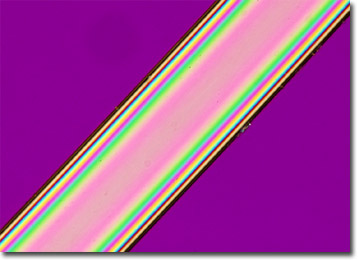Polarized Light Microscopy Digital Image Gallery
Saran Fiber
Saran is a trade name for polyvinylidene chloride (PVDC), a substance that was inadvertently discovered in 1933 when a worker at the Dow Chemical Company was unable to fully clean a piece of glassware. Within the container was an unusually durable material that intrigued the company’s scientists when it was brought to their attention and which they soon transformed into a greenish film that they dubbed Saran.

Saran was initially utilized by the United States military, who sprayed it on fighter planes and other equipment as a protectant against the elements. Carmakers also utilized an early version of the material in upholstery to make it more resilient. Later, after scientists were able to eliminate its greenish hue and foul scent, Saran was found to be an ideal material for food packaging. By 1949, Saran Wrap was introduced by Dow as the first commercial cling wrap, and only a few years later it became a common household product used to securely wrap countless sandwiches and cover innumerable leftover items.
The molecular structure of Saran is what makes it such a useful material. Formed from the polymerization of vinylide chloride with various monomers, the molecules of Saran are bound so tightly together in such a complex design that it is extremely difficult for other molecules to penetrate it. Thus, as a film, the polyvinylidene chloride acts as a remarkable barrier against oxygen, water, and aromas. Saran is also resistant to acids, bases, and solvents, which has made it popular in the industrial sector, where it is commonly utilized in conjunction with other polymers.
